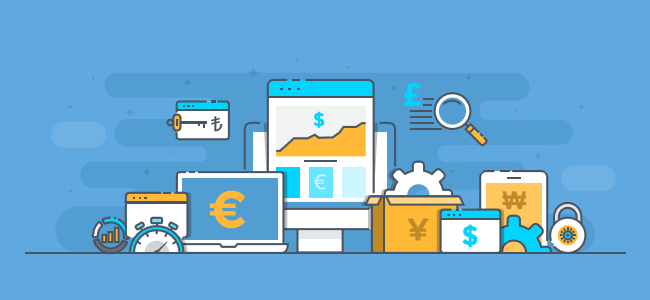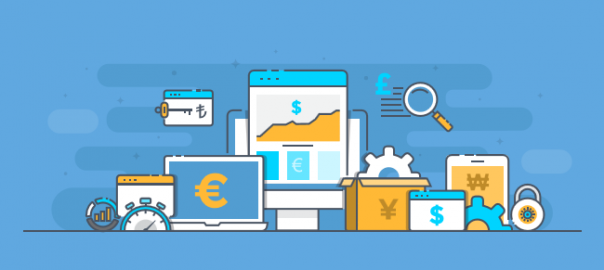
Global adoption creates opportunities for businesses that include reaching new customers and increasing brand visibility. With that said, you should consider selling your products or services cross-border. But, you also want to make sure your customers need it.
The most favored online retail markets by global cross-border shoppers are U.S, China, and the U.K. According to Online retail cross-border sales whitepaper, 35% of worldwide customers shop on websites based outside their home country. The numbers are different, depending on the country, e.g. 90% of Canadians purchase cross-border, and in Japanese, it’s less than 60%. The same report estimates that the total global revenue of retail sales will be at about $ 2 trillion by 2018.
IPC Cross-Border E-commerce Report 2010 reveals that one-third of online consumers in Europe purchase physical goods from other countries. According to more actual research, cross-border purchases are on the rise and the survey hosted by the leading consumer organization in the UK reported that 66.4% of EU online shoppers have bought goods or services from a retailer based in a different EU country. What’s more, almost two-thirds of respondents shop regularly from websites based in their home country and only 10% choose cross-border.
Displaying prices in local currencies
Accepting payments in various currencies is not only convenient for customers, but may mitigate the risk of chargebacks. You can run a global business and make your customers feel at home while making purchases.
Listing prices in local currency and allowing users to pay in the currency based on their location matters. You can charge UK customers in pounds, US customers in dollars, Spanish clients in euro, etc.
Let’s say you sell T-shirts online and your business is based in the UK. That’s why you’ve decided to list the prices in GBP only, even though you allow abroad customers to buy your products.
Imagine that someone from Australia buys a £20 T-shirt on your website and after a few days sees $ 32.64 on his bank statement.
Of course, he could double check everything before pushing the Pay button, but online purchasing usually comes with speed and convenience. People don’t have time for a long shopping process, so the currency difference could easily be missed.
What’s more, ever-changing exchange rates may result in higher prices which could lead to the customer getting frustrated.
This is just an example, but it happens so often that you should consider providing your customers with multi-currency payment processing to mitigate chargeback risk.
No one likes surprises on payments and ever changing prices. Offering the ability to pay in a customer’s home currency makes online buying easier and eliminates the risk for online shoppers.
Becoming a global retailer
Expanding into international markets comes with lots of challenges and goals to reach, but it also helps drive more sales and creates a more competitive company which can become a key player on the market.
Making sales in foreign markets should be connected with accepting payments in customers’ home currencies. There are many solutions to start selling internationally (e.g. with SecurionPay you can process payments in 160 currencies), so it’s good to know the benefits of reaching consumers abroad.
Before you start selling online, do research to learn what the most preferred payment methods are for your target audience. There’s no one solution that fits all. Offering multiple payment options usually improve the number of sales and conversion rate. The same goes with offering payments in multiple currencies.
Prepare to compete for foreign consumers as well. You need to do research on not only payment methods preferred by local shoppers, but also their shopping habits, etc. All that knowledge would be helpful to optimize your marketing efforts and achieve the best results.
Selling globally also comes with a higher risk of fraud. There are a few things to watch closely in order to mitigate the risk. What should you pay attention to?
1. Track the countries
When you sell globally, check orders twice. Be especially careful with orders from Asia or Africa as they are countries with higher instances of fraud.
Look closely at IP addresses from outside the country, but make sure it could be a fraudulent activity before you accuse a customer. If you have any doubts, contact the customer to confirm that they actually ordered the item.
2. Email address
Email addresses can also set off alarm bells, especially if it contains strange names. For example, hellofromfraudster@somedomain.com or givemethe$ $ $ @gmail.com. It doesn’t mean that every ridiculous email address is suspicious. Don’t overreact, but be careful and listen to your gut.
Look closely at orders when a customer uses an anonymous email service. These services are frequently used by fraudsters because they don’t give personal information to merchants or the police.
3. Time of ordering
Everyone knows that you can shop online anytime you want, 24/7, but you should pay special attention to late night and early morning orders. Fraudsters usually make purchases during this period.
You can also look closely at orders with express shipping because it’s one of the common shipping methods chosen by fraudsters. They also usually make costly orders in high quantities.
Another thing to watch is repeated attempts to order an item or service on the same card. Making unusual orders, such as a large number of orders from a specific country or from similar regions and more expensive orders are also things fraudsters commonly do.
4. Shipping address
Consider canceling an order shipment when you see that the shipping address looks weird or is different from the billing address. In this case, it’s good to ask the issuing bank to get in touch with the customer. Fraudsters often give wrong phone numbers that don’t match with the credit cards they use to make an order.
Also, remember to update your network security systems and find a company that offers highly effective fraud protection service.
Even if you notice the things mentioned above, it doesn’t mean the transaction is fraudulent. Just be careful with the orders made on your website and listen to your gut.
Also keep in mind that issuers monitor shopping patterns, so sometimes when a customer wants to make a payment that’s not in their local currency, an issuer may suspect fraud.
Main cross-border obstacles
The main reason that 67% of consumers buy abroad is because there are lower prices outside their country. There is also a wider range of products and greater accessibility of brands that aren’t available in their country. It’s the greater choice and taking advantage of lower taxes and currency exchange that is appealing.
But, selling globally also comes with some problems for online buyers.
ANEC research shows that 15,2% of Europeans who have shopped cross-border, have experienced problems with a transaction. Some of the reasons they mentioned were unexpected charges, not offering adequate means for cross-border payment, or not offering information in another language.
Over to you
If you want to improve your business performance, it’s in your best interest to provide a customer-friendly solution for online shoppers.
When you offer multi-currency prices, your customers don’t have to pay extra fees for currency conversion so it can have a positive impact on your sales numbers. No one likes extra costs. Customers are more likely to buy from your site repeatedly when you allow them to pay in their local currencies.
What’s more, it’s easier for online customers to compare prices when they can predict the real cost. They are more likely to complete a purchase when they can pay in their preferred currency or in their local language.
If they are charged extra fees, they could request a refund or issue a chargeback. Client’s also can get frustrated and dissatisfied when this happens and could result in them losing trust in your brand.
Especially in e-commerce, it’s better to provide a local shopping experience by displaying products in local languages, currencies or even size charts. Creating a checkout experience tailored to a certain market could be a win-win situation. It’s easier for customers to understand their costs, you’re able to accept payments with convenience, without worrying about conversion fees, and reducing the chance of cart abandonment.
Want to add anything? Don’t hesitate to leave a comment!
Business & Finance Articles on Business 2 Community(21)








